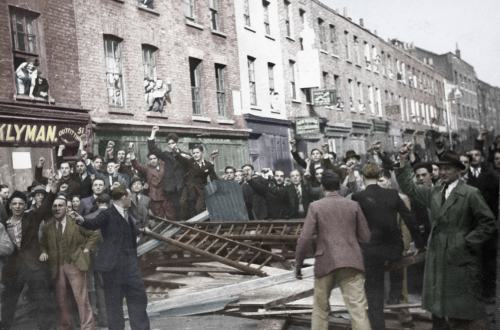This is a cross post by Aymenn Jawad al Tamimi from The Jerusalem Post
Last week, the UN released a report warning that the conflict in Syria had now become “overtly sectarian in nature,” while a spokesman for the UN secretary general Ban Ki-Moon expressed concern about “extremely worrisome reports…of a mass killing of civilians in the village of Aqrab near Hama.”
This alleged massacre is said to have resulted in the deaths of at least dozens of Alawite civilians in a town with a Sunni majority that has co-existed alongside the Alawite minority.
However, uncertainty still remains as to what happened in Aqrab. The first account of events to appear in English-language media — illustrated by a New York Times report published on December 12 — came from rebel sources, which released multiple videos purporting to give the testimony of Alawite survivors from the town, now supposedly being protected by the rebels and being treated for their wounds.
These purported witnesses said that they had been rounded up by Alawite shabiha and held hostage in a building as the rebels approached Aqrab. Then, to avoid the disgrace of capture by the rebels, the Alawite militiamen killed many of their own hostages.
Yet a couple of days later, a report was released by Alex Thomson of Channel 4. Travelling into pro-Assad areas near the town of Aqrab but unable to enter Aqrab itself, Thomson interviewed three witnesses in separate locations (and spoke with a dozen or so other Alawites) — claiming that it was actually the rebels who held them hostage after attacking the town and deprived them of most basic necessities. The three witnesses were all said to be from Aqrab and part of the Alawite community there.
The rebels supposedly wished to use the Alawites as human shields in the nearby town of Houla, which was the site of the massacre of 108 Sunni civilians by shabiha.
A delegation — including the town’s local Sunni imam and mayor — then tried to negotiate for the hostages’ release, only to reach a deadlock that culminated in gunfire through the building in which the Alawites had been gathered by the rebels.
Eventually, some 70 hostages were released and taken by bus to the nearest village, but one bus took a few of the hostages to al-Houla, where they were treated at a rebel-run hospital. It is believed that these are the ones who were filmed by rebels to give testimony that blamed shabiha.
Before assessing the validity of Thomson’s account, it should first be noted that those who wish to malign him as having an axe to grind are wrong. Thomson has simply reported what his interviewees told him, and nothing more.
However, it is apparent that Thomson’s account of the events in Aqrab is not the first of its kind. At the same time as the New York Times report came out, the pro-regime propaganda site SyriaTruth, which has previously purported to expose me as an Israeli spy in Iraqi Kurdistan, released a ‘preliminary’ article — drawing on information ‘exclusive’ to SyriaTruth — that matches a number of details in Thomson’s report.
For example, one of Thomson’s witnesses claims that the rebels who took the Alawites hostage were not Syrian Arabs. SyriaTruth’s purported sources claim the same thing, identifying them as 500 men of Turkmen, Lebanese, other Arab and non-Arab origin. Both accounts also identify the fighters as being from Houla (SyriaTruth does not mention Rastan).
The problem with this claim that the rebels in this case were foreigners is that it would then not make sense for these fighters to assure the hostages that they are “brothers from al-Houla and al-Rastan, your Islamic brothers” (to quote one of Thomson’s witnesses).
Foreign fighters in these conflicts are invariably hardline jihadists who deem Alawites to be infidels in some form (whether by virtue of supposedly being Shi’ite or completely outside Islam), and do not disguise their animosity.
Further, there is no evidence of a substantial and active foreign fighter presence in Houla or Rastan. In truth, the claim that the perpetrators of alleged massacres and other gross abuses against minorities are not from Syria has become a standard trope, largely intended to fit the pro-Assad narrative that Syria is being undermined by a fundamentally foreign conspiracy.
Other points of overlap between SyriaTruth and Thomson’s account include the motivation for the hostage taking (i.e. to use some of the Alawites as human shields in Houla) and the negotiations that led to the release of some 70 hostages (in SyriaTruth, the figure is given as 70-90 hostages). From these similarities, it is hard not to infer that SyriaTruth has used the same sources as Thomson.
Crucially, however, SyriaTruth goes further in vouching for the existence of a massacre, giving a figure of 180-210 Alawites killed, along with some 20 Sunnis who tried to defend them from the rebel attack on Aqrab.
Another pro-regime site — Shukumaku, which is much less widely read than SyriaTruth — in a report on 12 December, puts the total number of those massacred at 235, among them 88 women and children (SyriaTruth gives a figure of roughly 90). Like SyriaTruth, Shukumaku claims the attack was the work of foreign militants, of the ‘takfiri’ type.
Yet as Thomson noted in a subsequent blog post at Channel 4, neither side has produced any strong evidence for the existence of a massacre in Aqrab. No video footage of the bodies of the dead, no photos of the aftermath of the alleged carnage: in short nothing like the clear and graphic evidence that came to light in the case of the Houla massacre, which sites like SyriaTruth falsely claimed was a rebel hoax.
Coming to the rebel account, the fact is that no one has given a convincing answer to the objections Thomson raised to this version of events.
For instance, rebel sites claimed that the building in which the hostages were held was destroyed by government airstrikes and artillery, when film footage of the town from a distance — produced by Channel 4 — showed quite clearly that the building was still intact.
Further, if Aqrab were a case of Alawites being held hostage by shabiha, why did the rebel sites make no mention of this from December 2 onwards, which by all accounts is the date when the rebel offensive on Aqrab began? As Thomson puts it, it would have been ‘an enormous propaganda coup’ for the rebels.
As for the video testimony released by the rebels, it can immediately be objected that the purported eyewitnesses will evidently say whatever the rebels want them to say.
On balance, therefore, it seems more likely that Aqrab was a case of a mass hostage taking of Alawites by the rebels, rather than the shabiha.
However, it is unlikely the perpetrators were foreign jihadists, and there is no decisive evidence that attests to there being an actual massacre, but the hostage crisis probably prompted all of Aqrab’s Alawites to flee.
In terms of motivation, rather than a supposed plan to use the Alawites as human shields in Houla, the hostage-taking fits into the context of a wider rebel offensive in the rural areas surrounding Hama and closing in on the city that was the epicenter of an Islamist uprising against Hafez al-Assad’s rule in the period 1976-82.
Generally, regime forces are increasingly yielding control of rural areas to rebel forces, focusing their efforts on defending urban centers instead. This explains the lack of a counter-offensive to retake the town from the rebels and the apparent participation of Hama government officials to have hostages released from the town.
Some may view the coverage of this affair in Aqrab as indicative of a mainstream media bias towards the rebels, but the reality is that until claims of a massacre of Alawites first emerged (i.e. several days after the rebel offensive on the town began), events in the town had gone unnoticed by all media sources.
Just as in Iraq, where many incidents of violent deaths at the hands of insurgents and coalition forces, and cases of ethnic cleansing by rival militias went unreported, so too will numerous cases of clashes between rebels and regime forces, violent deaths and developments in the vicinity of many villages in Syria go unreported.
For comparison, note the hitherto unreported rebel push towards the coastal city of Latakia, which has led to the capture of numerous Alawite villages and prompted the flight of their inhabitants.
The problem is that in Syria the issue of events going unreported is greatly exacerbated by the restrictions on foreign journalists entering and travelling around the country.
To conclude, I would emphasize that I do not claim definite truth to the sequence of events in Aqrab that I have tried to reconstruct. I am not in Syria, let alone Aqrab.
Only a third-party investigation by the UN that must include a visit to the town and an extensive overview and cross-examination of purported eyewitness testimony can give a conclusive answer to what precisely happened in the town at the start of this month.
Circumstances may well prevent such an investigation from ever being carried out, and it could be that, just as with the many videos of the Syrian civil war uploaded to YouTube, we will never definitely know the full truth.


